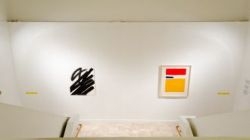
Alima / Louise Nevelson
Alima
1932, Nesher
2013, Tel Aviv
Alima passed away in June 2013, when she was 81. Just three months earlier, still full of vigor, she took part in the launching event for this exhibition, and prepared a work in tribute to the American artist Louise Nevelson. In the course of this event, Alima told about her encounter with Nevelson and her works at the 1962 Venice Biennale. Alima was then at the inception of her career, several years prior to the artistic breakthrough marked by her creation of abstract, colorful screenprints. Her unusual creative trajectory, which was characterized by a surprising combination of restrained minimalism and a fresh, bright palette, was unique in the context of Israeli art.
Louise Nevelson
1899, Kiev, Russia
1988, New York, USA
Louise Nevelson was born in Czarist Russia into a Jewish family that immigrated to the United States in the 1920s. She began working as a sculptor in the 1930s, and presented her first solo exhibition in 1941. By 1962, when her works were exhibited in the American Pavilion at the Venice Biennale, she was a well-known artist, and one of the few successful women artists in the largely masculine American art world. Nevelson was known for her large-scale works, which were composed of wooden parts and ready-made objects she collected throughout the city. She covered these numerous elements with uniform layers of black, white, or gold paint, forming them into monumental reliefs. As she put it: "Art and creation was not art and creation, but it was a place to live in, and breathe in. There was no question about it, so I had no choice. Either you stay there, or you cut your throat." Today, Nevelson is considered to be one of the most important American women artists of her generation, and one of the first women artists whose achievements were recognized during their own lifetime.